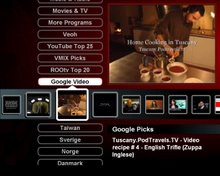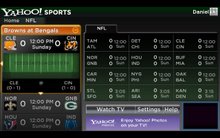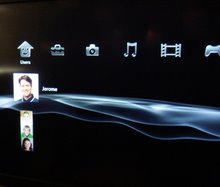The Issue: Speaking at the MediaGuardian Edinburgh International Television Festival, the well informed Ashley Highfield’s remarks imply that the TV industry has as little as two years to create a viable digital businesses or face the TV equivalent of an "iTunes moment”. Which others have described as record labels ceding control over digital asset distribution to the Apple juggernaut.
Background: After years of effort by many companies to combine TV and Internet, no widely accepted video appliance or networked-TV has emerged. Does Highfield see that this is about to change? Is Apple now positioned for a dominant position in the TV platform and service business? Or is Highfield referring to something other than Apple technology?
Behind the scene: Apple is rumored to soon introduce a new ‘iPad’ (i.e. large Apple Touch). A new Apple-TV is also expected. Are these the platforms that will finally bring convergence between web and TV? Highfield opines, "Once this happens the shift of spending from TV to web will accelerate even more".
It has been two years since blogging began on possible next-steps for the Apple-TV. In this time Apple has made great strides in feeding expectations for extensive software application support on smart phones. This has caused the established hardware-oriented phone builders to scramble to develop their own software application infrastructure. Efforts, such as Android and Ovi are manifestly attempts to protect against further erosion of the high-end mobile phone market to the iPhone onslaught. This erosion has initially been most noticeable in the
The iPod has also developed into a software application platform in the form of the Apple Touch. Both Touch and iPhone support a “full browser” experience based on WebKit, and also application software programs built using the Apple SDK. Building a Pad-like device based on the same technology would enable Apple to build a lower-cost web access or web-browsing device without underselling its existing MacBook market and with access to the extensive catalogue of iPhone applications (some 60,000+ strong). What might be called an ‘iPad” could not support the full range of applications supported by a Mac or MacBook, but would nevertheless offer a compelling Internet and application enhanced appliance.
The original Apple-TV was based on PC technology. This has a much higher hardware cost than a Touch. The Apple-TV does not make use of this additional hardware capability; it’s a cost tax without major benefit. Now, however, Apple would appear to have the technology to build a next-generation Apple-TV based on Touch technology instead, which would likely require better graphics resolution for the larger TV screen. This development step is likely required for an iPad device as well.
A lower-cost Apple-TV could make headway in the
The lower cost hardware would also better support a co-branded networked Apple-TV with Touch technology “built into the glass” (as they say in “industry-speak”). With these steps, Apple will have moved the modern TV to a software application platform, much like it is moving the mobile phone to a software platform. Many of the existing TV and STB suppliers would struggle to respond. I suspect a large portion of the “window in which to respond” that Highfield refers to would be consumed while waiting for company accountants to confirm loss of market share. Thus making it safe in these difficult career times for product managers to engage in reactive-product development. Apple would have lit the green light, signaling the rush of competitive new products.
Highfield stated, "So, realistically, I think the industry has about two to three years to adapt or face its iTunes moment. And it will take at least that long for media brands to build credible, truly digital brands. But, importantly, I do believe TV does have a small, two to three year window in which to respond…"
Software application developers benefit from the efficiencies of a common platform such as the PC. The PC’s dominance is why we see new applications such as the iPlayer first appearing on the PC, even before the Mac. It is simply a matter of quickly reaching the greatest number of users. A common TV platform based on some form of Apple-TV would rapidly gain the attention of application developers. This assumes the new Apple-TV supports iTunes store-enabled applications. Albeit, with Apple having the final say on what applications are acceptable - this is likely to lead to some conflicts. Without some degree of support for independent application developers, the new Apple-TV would not be considered a common platform. Consequently, it would have a slower market acceptance and pose less threat to its competitors, and therefore extend the window in which to respond.
An Apple-TV which only supports iTunes would give Apple greater control over revenues generated by web-TV convergence. It would also simplify any competitor’s ability to rally the software community to support an alternative approach and platform. This might be based on a WebKit- or Adobe Flash-based range of boxes and TVs. However, the industry’s reluctance to embrace software technology has resulted in years of waiting for the ideal convergence TV platform. The failure to make do with technology now readily available is now likely a greater problem than mastering the business changes inherent with convergence. Again, this may well play to Apple’s advantages by keeping the software community fully occupied developing new applications for the iPhone, Touch, ‘iPad’, or any new Apple-TV.
Apple also has the opportunity to combine the operation of the iPhone or Touch with the PC or Mac and the Apple TV. Ecosystem-enabled smart application software holds the promise of finding relevance with web-savvy consumers and service providers. It will be interesting to see how Apple balances decisions regarding conflicting agendas for openness, exclusivity, and inclusion of non-revenue generating features, such as digital recording and ATSC tuners, or DVD playing. To achieve market dominance it has to ease new ideas into a wide audience which still finds value in existing, low-cost and well-understood TV-related appliances. Both Microsoft and Sony have not found this an easy nut to crack, despite major undertakings using their game platforms.
We should know soon whether the iPad is launched and the Apple-TV receives a refresh, and if Ashley Highfield’s predictions prove correct, the clock is ticking for competitors to make the next move.
Daniel Mann








